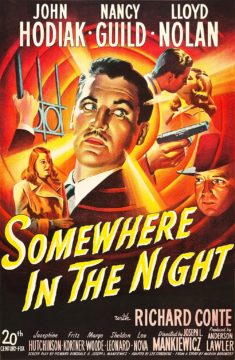Imogen Sara Smith at Current:
 Bunker Hill was film noir’s favorite neighborhood. In the 1940s and ’50s, the once-exclusive area of downtown LA, with its rambling Victorian mansions, was attractively seedy and decaying, and supremely photogenic. The steep streets create natural Dutch angles, and the long stairways slice diagonally across the screen, vertiginous and crooked like something in a bad dream. Angels Flight, a whimsical funicular railway, is an instantly recognizable landmark. The houses have tall, narrow stoops with cagelike porch railings and flaking scrollwork, stained-glass transoms, and other emblems of scuffed and dingy grandeur. Most are cheap rooming houses, with sour, suspicious landladies and tenants whose faces and fortunes sag like the buildings. “Bunker Hill is old town, lost town, shabby town, crook town,” Raymond Chandler writes in his 1942 novel The High Window. Its tawdry charms lend flavor to Cry Danger (1951), Chicago Calling (1951), and The Turning Point (1952). In Robert Siodmak’s Criss Cross (1949), Burt Lancaster returns to his mother’s Hill Street home, convinced he has finally gotten over his ex-wife, only to immediately tumble back into the gravitational pull of their bruising relationship.
Bunker Hill was film noir’s favorite neighborhood. In the 1940s and ’50s, the once-exclusive area of downtown LA, with its rambling Victorian mansions, was attractively seedy and decaying, and supremely photogenic. The steep streets create natural Dutch angles, and the long stairways slice diagonally across the screen, vertiginous and crooked like something in a bad dream. Angels Flight, a whimsical funicular railway, is an instantly recognizable landmark. The houses have tall, narrow stoops with cagelike porch railings and flaking scrollwork, stained-glass transoms, and other emblems of scuffed and dingy grandeur. Most are cheap rooming houses, with sour, suspicious landladies and tenants whose faces and fortunes sag like the buildings. “Bunker Hill is old town, lost town, shabby town, crook town,” Raymond Chandler writes in his 1942 novel The High Window. Its tawdry charms lend flavor to Cry Danger (1951), Chicago Calling (1951), and The Turning Point (1952). In Robert Siodmak’s Criss Cross (1949), Burt Lancaster returns to his mother’s Hill Street home, convinced he has finally gotten over his ex-wife, only to immediately tumble back into the gravitational pull of their bruising relationship.
more here.
